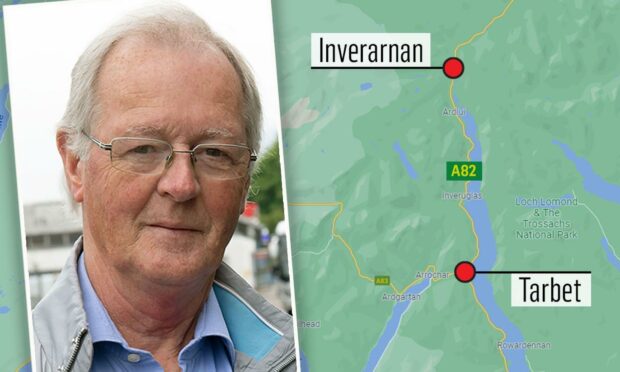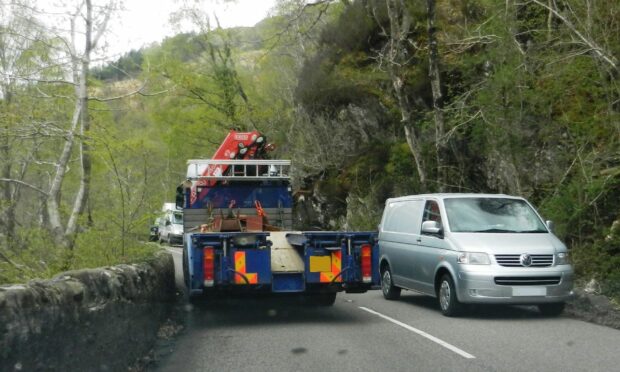Plans to improve a stretch of the notorious A82 trunk road have been welcomed as “transformational” by transport body Hitrans.
Transport Scotland is seeking views on a planned major upgrade of a 10.5-mile part of the route between Tarbet and Inverarnan.
Hitrans says the route as it stands is not “fit for purpose”.
The trunk road is a strategic link connecting the Highlands to the central belt and a key tourist route to the north.
It is also the diversion for the A83 trunk road when the Rest and Be Thankful is impassable.
Accident rates higher than national average
However, accident rates on that stretch are considerably higher than the national average.
Between 2015 and 2019, there were 48 accidents between Tarbet and Inverarnan, two of which were fatal and 19 serious.
The proposed improvements between Tarbet and Inverarnan include carriageway widening and upgrades to the current substandard trunk road alignment.
A consultation was launched last month, along with an interactive story map to provide updated information.
It states the Tarbet-Inverarnan road is generally below standard width, often narrowing to below six metres, with no paved boundary and substandard verges along the roadside.
The section is characterised by tight bends and reduced visibility, with large vehicles having difficulty passing.
Among the factors highlighted as contributing to slow and dangerous conditions are the narrow ‘Seven Bends’ stretch, poor drainage leading to surface water on the road and limited space for maintenance.
The proposed scheme will largely follow the existing A82 and will include a shared path for pedestrians and cyclists.
It includes a 7.3-metre wide carriageway, with one metre paved hard strips next to both sides of the road.
Communities rely on the A82
In its response to the consultation, the Highlands and Islands Transport Partnership (Hitrans) says communities rely on the A82 for almost every aspect of the economy.
This includes the movement of freight, public transport and tourism, as well as local access to key services and to Glasgow.
Hitrans chairman and Highland councillor Allan Henderson said: “This section, which is only 40 miles from the centre of Glasgow, is currently not fit for purpose with HGVs and coaches unable to pass each other without mounting the verge at several locations.
“We therefore welcome the proposals for the final scheme included within the consultation.
“The proposed solution for a 7.3-metre carriageway plus hard strips, together with a segregated active travel route on the shores of Loch Lomond, present an opportunity to deliver a transformational improvement for all users.”
Mr Henderson says the proposals will help tackle road safety and other issues affecting the section.
These include:
- Improving journey time reliability and reducing carbon emissions
- Reducing driver frustration
- Improving the resilience of the west coast road network by reducing closures from flooding and vegetation clearance
He is impressed by the proposed new alignment of the corridor, in particular at sections such as the ‘Seven Bends’.
Improved public transport connections
In addition, a segregated active travel corridor on the shores of Loch Lomond will open up the area to walkers and cyclists for the first time.
He also welcomes improved connectivity to public transport the scheme would offer at Ardlui, with better access to the rail station and bus laybys at Tarbet.
In relation to the scheme’s link to the A83 Mr Henderson said: “Hitrans is of the view that Transport Scotland should ensure that there is a single governance structure overseeing the delivery of both the A82 and A83 upgrades.
“This will help ensure that the phasing of the two projects is complementary and any conflicts between the implementation programmes for the two schemes are resolved.
“Hitrans would support the commencement of the statutory processes for the A82 Tarbet to Inverarnan scheme at the earliest opportunity.”
This section, which is only 40 miles from the centre of Glasgow, is currently not fit for purpose.”
Allan Henderson
He recognises the significant challenges in delivering the project given the length of any diversion routes.
“We support the principle of restricting construction where possible to the October-Easter period.
“We also support overnight closures as a means of extending the construction period and reducing the project delivery timescales and think that as with the Pulpit Rock scheme, the public will recognise the short-term impact for long term gain.
“Identifying the sections which should be prioritised within the programme is challenging.
“Having reviewed the most recent proposals we feel there is a strong argument to support progressing those less challenging sections first so that the length of route where delays are experienced can be reduced more quickly by progressing the easier to deliver sections first.”


